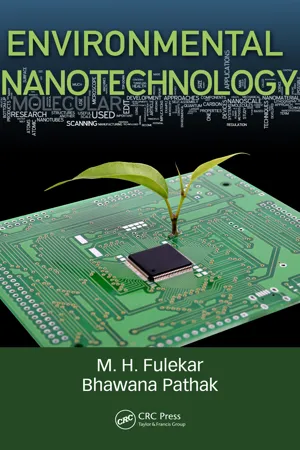
- 340 pages
- English
- ePUB (mobile friendly)
- Available on iOS & Android
Environmental Nanotechnology
About This Book
Environmental nanotechnology is considered to play a key role in shaping of current environmental engineering and science practices. This book titled "Environmental Nanotechnology" covers the advanced materials, devices, and system development for use in the environmental protection. The development of nano-based materials, understanding their chemistry and characterization using techniques like X- Ray diffraction, FT-IR, EDX, scanning electron microscope (SEM), transmission electron microscope (TEM), high resolution-TEM, etc is included. It also highlights the scope for their applications in environmental protection, environmental remediation and environmental biosensors for detection, monitoring and assessment.
Key Features:
-
- Covers basic to advanced Nano-based materials, their synthesis, development, characterization and applications and all the updated information related to environmental nanotechnology.
-
- Discusses implications of nanomaterials on the environment and applications of nanotechnology to protect the environment.
-
- Illustrates specific topics such as ethics of nanotechnology development, Nano-biotechnology, and application in wastewater technology.
-
- Includes applications of nanomaterials for combating global climate change and carbon sequestration.
-
- Gives examples of field applications of environmental nanotechnology.
This book covers advanced materials, devices, and system developments for use in environmental protection. The development of nano-based materials, understanding its chemistry and characterization by the use of X-Ray diffraction, FT-IR, EDX, scanning electron microscope (SEM), transmission electron microscope (TEM), and high resolution-TEM give the scope for their application in environmental protection, environmental remediation, and environmental biosensors for detection, monitoring, and assessment. The green chemistry based on nano-based materials prevents pollution and controls environmental contaminants.
Frequently asked questions
Information
| Table 1.1 Nanoparticles Properties and Their Applications | |
| Property | Application |
| Optical | Anti-reflection coatings. Tailored reflective index of surfaces. Light-based sensors for cancer diagnosis. |
| Magnetic | Increased density storage media. Nanomagnetic particles to create improved detail and contrast in MRI images. |
| Thermal | Enhance heat transfer from solar collectors to storage tanks. Improve efficiency of coolants in transformers. |
| Mechanical | Improved wear resistance. New anti-corrosion properties. New structural materials, composites, stronger and lighter. |
| Electronic | High performance and smaller components, e.g. capacitors for small consumer devices such as mobile phones. Displays that is cheaper, larger, brighter and more efficient. High conductivity materials. |
| Energy | High energy density and more durable batteries. Hydrogen storage applications using metal nanoclusters. Electrocatalysts for high efficiency fuel cells. Renewable energy, ultra high performance solar cells. Catalysts for combustion engines to improve efficiency, hence economy. |
| Biomedical | Anti-bacterial silver coatings on wound dressings. Sensors for disease detection (quantum dots). Programmed release drug delivery systems. ‘Interactive’ food and beverages that change colour, flavour or nutrients depending on a diner’s taste or health. |
| Environmental | Clean-up of soil contamination and pollution, e.g. oil. Biodegradable polymers. Aids for germination. Treatment of industrial emissions. More efficient and effective water filtration. |
| Surfaces | Dissolution rates of materials are highly size dependant. Activity of catalysts. Coatings for self-cleaning surfaces, Pilkington’s glass for example. |
| Personal care | Effective clear inorganic sunscreens. |
Table of contents
- Cover
- Half Title
- Title Page
- Copyright Page
- Dedication
- Contents
- Preface
- Acknowledgements
- Authors
- 1. Environmental Nanotechnology: An Introduction
- 2. Chemical Synthesis of Nanoparticles
- 3. Biological Synthesis of Nanomaterials
- 4. Natural Nanomaterials
- 5. Development of Nanocomposites
- 6. Nano-Based Wastewater Treatment Technology
- 7. Nano Technological Applications: Sustainable Energy
- 8. Advanced Instruments: Characterization of Nanomaterials
- 9. Membrane Filtration Technology
- 10. Nanoparticles: Health and Environmental Risk
- 11. Advanced Research Case Studies
- Glossary
- Index